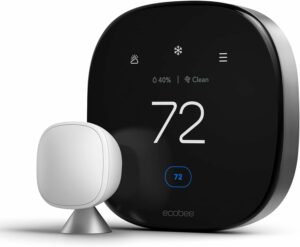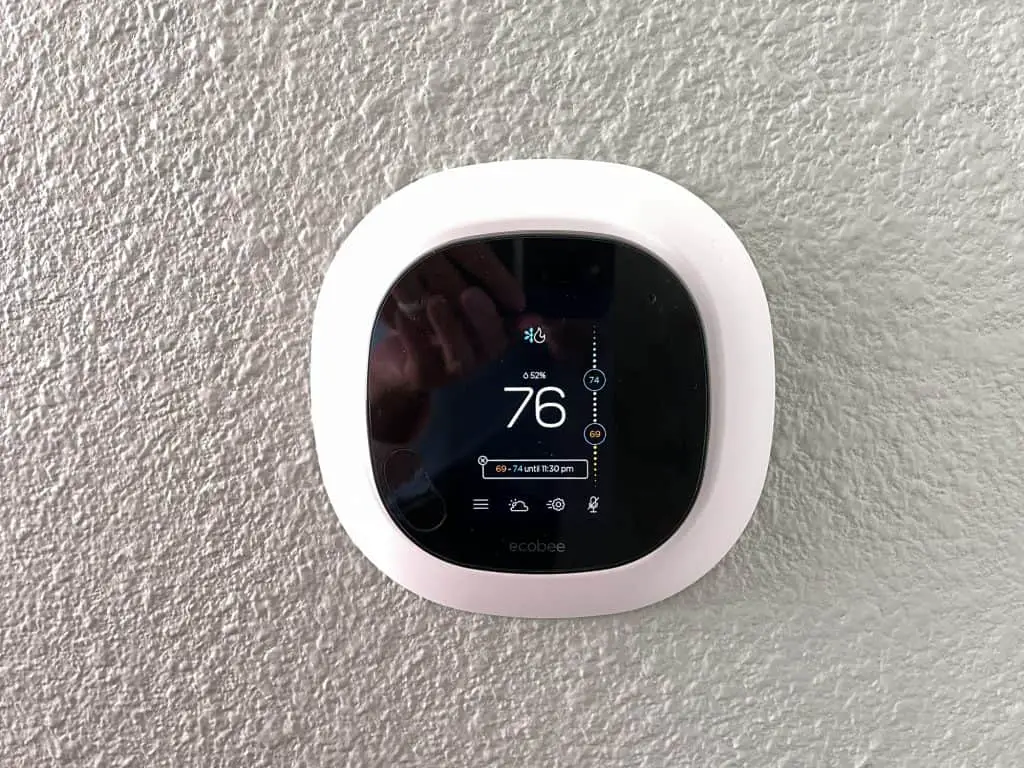The humidity level in your house is more critical than you imagine. The ideal level of humidity isn’t only essential for your hair, skin, and overall health, but it’s also essential for the health of your house, as humidity levels that are too high or too low can also damage your furniture or allow germs to thrive!
Lucky for you, EcoBee’s Thermostat can help you deal with that problem! This one is among the best solutions to control your house’s environment and HVAC systems, offering a wide range of features and settings to get the job done.
In today’s guide, we’ll walk you through a brief guide about controlling your home’s humidity with EcoBee like a boss! So with further ado, let’s dive right in!
What Is EcoBee?

EcoBee is a Canadian home automation company that makes a wide variety of products, including smart cameras, thermostats, sensors, and more!
What makes the EcoBee smart thermostat special is that it is capable of providing you with an accurate reading of the temperature in your house all the while giving your excellent control over the settings of the system using its smart features.
The device is elegant, easy to use, and integrates with a wide range of smart home hubs, including Google Assistant, Amazon Alexa, Samsung SmartThings, and Apple HomeKit!
In addition to all the regular features of a smart thermostat, the device also saves a lot of electricity by turning the HVAC system off when you open the windows.
Additionally, it’s capable of providing you with several means to control your indoor humidity level, whether it’s too high or too low!
The device also comes with a wide range of control features. In addition to integration with smart home hubs, you can also control the system using your smartphone and or even with your voice.
How Does EcoBee Smart Thermostat Work?
EcoBee Smart Thermostat is not just a hub device that gets its feedback and readings from a variety of smart sensors that you place around the house. In fact, the system itself is equipped with a built-in temperature and humidity sensor.
However, you can also pair the thermostat with a network of EcoBee Sensors for more accurate readings.
Can You Control Your Home’s Humidity with EcoBee?

One thing you should keep in mind is that EcoBee doesn’t have a built-in ability to control or adjust the humidity in your home.
Instead, EcoBee gives you the ability to control humidity in your house by controlling your already existing HVAC system.
In other words, the ability of EcoBee to control your humidity is correlated to the efficiency of your already existing HVAC system, so having an outdated or malfunctioning HVAC system will limit the device’s capacity.
EcoBee can also be connected to a variety of devices that control the internal environment, such as dehumidifiers, ACs, and fans, which have the ability to adjust the humidity in your house.
To control humidity using EcoBee, you should use the Humidity Correction features in the system settings, which allows you to set the humidity higher or lower by up to 10%:
Are EcoBee Thermostat Sensors Accurate?
One of the most common problems with thermostat sensors is that they lack accuracy, which makes them inconsistent when adjusting the humidity automatically.
According to EcoBee, the smart thermostat has an accuracy range of 1.0 degrees F (0.55 degrees C) above or below, which is a pretty high level of accuracy. However, EcoBee doesn’t disclose the specifications of its humidity sensor.
This accuracy is achieved using EcoBees sensors. The system uses the last two readings to create an average, which allows it to stay with a very accurate range.
Under default settings, the sensors will take measurements once every 15 seconds. This means that the system can also react to quick changes in the surrounding environment.
In real life, users also report that EcoBee’s thermostat is pretty accurate and reliable with an excellent response to change the temperature and humidity.
On the other hand, a few users have encountered issues with humidity readings. Luckily, these discrepancies are easy to fix by calibrating and syncing EcoBee devices.
This usually takes about 10 to 20 minutes to finish and many users never had to do it, but EcoBee made sure that it’s a simple operation that is done with a single push of a button to get the system readings accurate again.
How to Control Your Home’s Humidity with EcoBee

Now that you have a better idea about EcoBee and how it works, here’s how you can use the smart thermostat to control the humidity in your house.
While setting up the ideal humidity for your house, you’ll need to understand the concept of humidity and how it works.
The first thing you need to know is that while the temperature is measured in simple units, humidity is usually measured in percentage, which specifies the amount of water vapor suspended in the air. (More on the ideal humidity later)
1. Overcool Max
Start by setting up your EcoBee system and choosing the Overcool Max feature. This one is among the major settings responsible for regulating humidity in the device.
HVAC systems are usually set to stay within the specified temperature. However, with settings like Overcool Max, your HVAC will be able to decrease the temperature below the specified degree in order to control humidity.
While adjusting the Overcool Max, you can set it in terms of degrees it’s allowed to go down in order to compensate for the high humidity, which is controlled in terms of 0.5-degree increments.
There you’ll also be able to adjust these settings, such as increments of Overcool Max and percentage of desired humidity.
Keep in mind that both of these settings will work together with the AC to achieve the desired level of humidity using the power of your HVAC, which we’ll discuss in the “Dehumidify with AC” section.
Another great aspect of activating the Overcool Max features is that it is designed to turn itself off automatically whenever it reaches the desired humidity or when it reaches the maximum allowed decrease in temperature.
2. Set the Ideal Fan Settings
Another method that is slightly more powerful in controlling the humidity than the Overcool Max feature is using the HVAC fans.
If you set a fan to be “Always On”, it’ll quickly cycle fresh air in the room. The problem is, fresh air is usually humid air. To solve that, you can switch your smart thermostat into “Auto Fan”.
What this does is that it stops the fans when the humidity levels in the room rise and activates the HVAC system to cycle the humidity out of the house.
3. Dehumidify with the AC

Another setting that also helps in adjusting the humidity through EcoBee is “Dehumidify using AC”. you can easily access these settings by opening the menu and going into the settings.
What you need to know here is that your AC is the most powerful system that can get rid of extra humidity in the house. Not only that, but it’s also the fastest system that can do it.
Unlike room temperature and warm air, cold air doesn’t have the capacity to carry water vapor. So, as the temperature in a room is reduced, the humidity should also go down.
4. Find the Ideal Indoor Humidity Level for Your House
As you now know, humidity is measured in a percentage. Another difference between humidity and temperature is that humidity is relative to where you live, the climate in your house, and the material your house is built of.
In fact, humidity is so relative that there’s no official agreement on the ideal level of humidity for a house.
However, the general consensus is that a range of 30% to 65% is supposed to be tolerable for most people, although the majority of reports believe that 30% to 50% is more ideal.
You should also factor in that humidity has an impact on our health. For example, humidity levels that are too low can trigger asthma and allergies.
The best way to figure out the right humidity for your needs is to set the humidity at about 40% to 45% and adjust humidity up or down depending on your comfort level.
Final Thoughts
This wraps it up for today’s guide that shows you how to control your home’s humidity with an Ecobee thermostat.
As you can see, the smart system offers a wide range of features that will manage your indoor humidity using a variety of brilliant features, even if you don’t own a dedicated humidifier to get the job done!